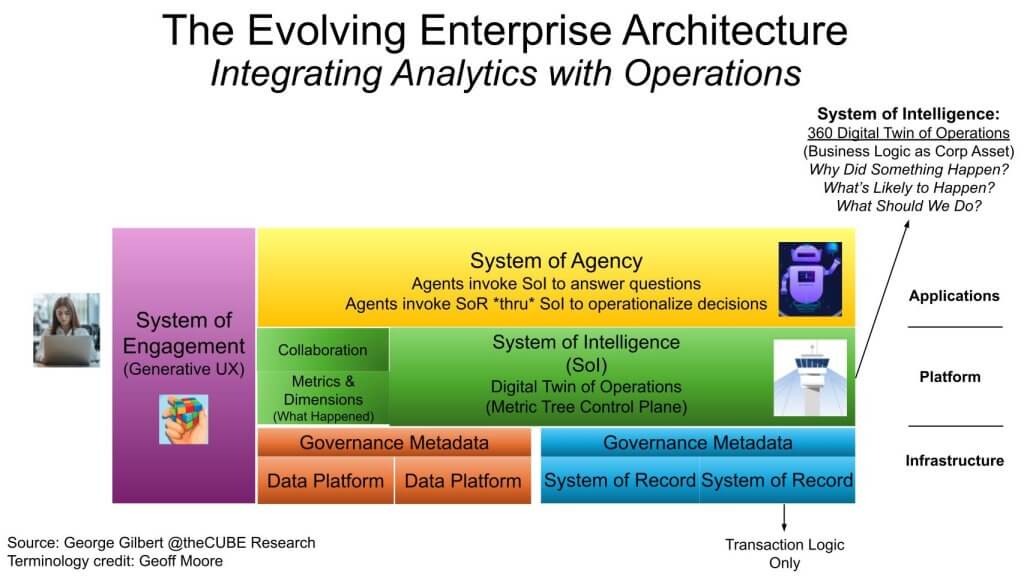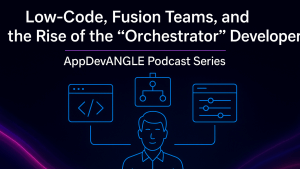At the AWS NYC Summit 2025, we saw clear signs that AWS is determined to lead in the agentic era of software development. In our view, Amazon is doubling down on its developer-first ethos, eliminating heavy lifting, and delivering foundational primitives that simplify the creation, deployment, and operation of AI agents. However, as AWS pushes hard to support developer-led agentic innovation, its challenge remains twofold: 1) Articulating a clear vision to the C-Suite for how business will be reimagined in the AI era; and 2) Bridging the architectural gaps, especially around what we call the “System of Intelligence” (SoI) layer, which we see as critical for effective AI agent deployment at scale.
Nonetheless, AWS continues to make impressive progress as it builds on the announcements from last year’s re:Invent. We’re just past “halftime” of the Amazon year and the NYC Summit always provides a good checkpoint to evaluate how quickly the company is delivering on its promises from December, what gaps it is filling and what still needs to be accomplished before re:Invent 2025.
TL;DR
AWS is removing friction for developers by delivering a managed services stack – AgentCore – that addresses the complexity of building, securing, scaling, and governing AI agents. AgentCore is the most consequential announcement from the AWS NYC Summit 2025. In our view, it marks a step-function leap in operationalizing AI agents at scale. With modular services purpose-built for real-world agent deployments – spanning runtime, memory, identity, tool access, observability, and browser/action tooling – AgentCore aims to remove the architectural friction that has historically kept agent-based systems stuck in proof-of-concept purgatory. It is designed to abstract the dynamic nature of agent workflows behind a secure, serverless, and interoperable control plane. AgentCore is not a framework, rather it’s corse infrastructure. And in our opinion, it positions AWS as a production-ready platform for agentic computing and represents one of the most capable on the market.
A new architectural direction is forming around agent infrastructure, but the enterprise “System of Intelligence” layer is still nascent and missing from the story. While AWS is not alone in facing this gap, we believe leaders in the AI era will address this critical capability as articulated later in this post.
Standards and interoperability Get More than Lip Service – AWS is actively contributing to MCP and A2A protocols to make multi-agent systems work across environments. It’s posture is clearly more inclusive as a recognition that not all work will reside in the AWS cloud. That said, AWS wants to be the best place to build, deploy and manage agents with Bedrock as a critical middle layer of its 3-stack model designed to simplify developers’ lives and build trust.
The ecosystem has become a critical piece of the flywheel, with agents, tools, and integrations from third parties available in AWS Marketplace. AWS has the richest cloud infrastructure ecosystem in our view and is driving tangible value for partners. GSIs such as Accenture, Deloitte, TCS and others had a major presence at NYC Summit this year. That said, we’d like to see more visible collaboration with IBM and are somewhat surprised by the lack of emphasis on that front.
Despite the impressive innovation velocity, AWS’ messaging to the C-suite remains overly complex and developer-centric, limiting its strategic resonance at the board level. In the early part of this century, AWS turned the data center into an API and changed the world of IT forever. But it still speaks “geek” much better than it speaks “wallet” in our opinion. We’d like to see a more balanced narrative that provides clearer messaging to senior executives.
AWS: Powering the Developer Stack for the Agentic Era
Swami Sivasubramanian’s keynote laid the groundwork for the future of software as service-based, agent-driven systems. AWS is architecting an agent-native stack built on Bedrock, Nova models, and the newly announced AgentCore.
These primitives aim to remove the glue work developers traditionally take on – wiring identity, memory, browser actions, tool integration, and telemetry into production agent workflows. The goal is to make AI agents as easy to deploy as Lambda functions. In our view, if it lives up to its promises, this represents perhaps the most comprehensive developer infrastructure for agents available in the market today.
What stood out is how Amazon is blending the flexibility of primitives with new abstractions that stitch these elements together in a coherent experience. But that coherence is resonating clearly for developers, perhaps not as much for the enterprise decision-maker. That’s a key distinction we’ll unpack.
AWS AgentCore: Powerful Primitives with Guardrails
Amazon unveiled AgentCore, a suite of managed services purpose-built to solve the hard problems of getting agents into production. According to AWS, this goes beyond trivial agents or demo apps. With AgentCore, AWS claims it is tackling production reliability, memory persistence, identity, observability, and multi-agent orchestration – all while allowing developers to remain model- and framework-agnostic.

With apologies for the poor graphic above, the following summarizes the services available to developers within AgentCore:
AgentCore Runtime
The core execution environment is a secure, serverless runtime purpose-built for dynamic agent workloads. It supports multi-modal models, real-time operations, and long-running tasks of up to 8 hours – according to AWS, the longest runtime window in the industry. The runtime includes built-in checkpointing for resilience, ensuring that workloads can be safely paused and resumed without data loss. Architected with zero-trust principles, it includes full memory isolation to prevent cross-agent data leakage, and ships with native identity controls to enforce access boundaries throughout.
AgentCore Memory
This module introduces a sophisticated memory subsystem designed to mimic human cognitive patterns. It supports both short-term and long-term memory, enabling agents to retain context across interactions. Developers can store and retrieve memory with just a few lines of code, making it simple to build context-aware, personalized agents. According to AWS, fine-grained short-term memory enables agents to hold ephemeral facts (e.g., a user’s request earlier in a session), while long-term memory can persist preferences or recurring behaviors. Critically, the system automatically determines which data should be retained long-term, using importance-based memory transposition, ostensibly reducing developer overhead and cognitive drift.
AgentCore Identity
AgentCore Identity manages authentication and authorization across both agents and tools. It integrates with AWS-native services and major third-party identity providers – including Okta, Microsoft Entra, and others – to delegate identity control. It securely manages API keys, OAuth tokens, and scoped permissions, ensuring agents can invoke external tools with the appropriate privileges while minimizing lateral movement risk. This module is essential for multi-agent systems and tool orchestration where delegated identity and authorization must be tightly controlled.
AgentCore Code Interpreter
This capability enables agents to write, evaluate, and execute code in secure, isolated environments. Pre-configured runtimes are available for Python, JavaScript, and TypeScript, with support for additional languages via customization. Each agent operates within a sandboxed execution context, ensuring that arbitrary code execution does not compromise other workloads or the surrounding infrastructure. AWS indicates that this unlocks dynamic task-solving, mathematical reasoning, and logic chaining in production-grade agents.
AgentCore Browser Tool
A lightweight, secure, and high-speed cloud browser runtime allows agents to interact with web UIs and HTML-based applications. The browser environment is claimed to be model-agnostic and operates in a virtual machine-isolated environment for safety and performance. Agents can simulate clicks, scrolls, form fills, and scrapes, making this tool especially useful for automating workflows where APIs are unavailable or incomplete. It dramatically expands the accessible surface area for agents in legacy enterprise environments.
AgentCore Gateway
Transforms existing services – including APIs, Lambda functions, and SaaS apps – into MCP-compatible tools that agents can understand and invoke. Developers can wrap an API with semantic metadata in just a few lines of code, effectively exposing it to agent workflows. Gateway supports integration with systems like Jira, Slack, Salesforce, and more, and includes semantic indexing so agents can discover the right tool for the job. AWS claims this capability makes existing enterprise assets “agent-ready” without requiring re-architecture.
AgentCore Observability
This module provides full lifecycle insight into agent behavior with deep observability tooling. Developers can trace each step of an agent’s decision process using built-in visualizations and interactive dashboards. The system supports OpenTelemetry (OTEL) standards, allowing integration with existing observability pipelines and SIEM platforms. It also enables debugging, alerting, and root cause analysis – critical for building trust in autonomous systems operating at scale.
AWS aims to make AgentCore a mainspring of developer empowerment. While incredibly powerful, it underscores the complexity of building, deploying and managing agents in this new AI era. Capabilities like this are essential and strongly position AWS as a go-to provider for developers building intelligent, long-running, autonomous systems.
But what’s still missing is a declarative layer that defines goals and outcomes in the language of business. And that’s where the System of Intelligence conversation begins.
Defining the System of Intelligence
At theCUBE Research, we define the System of Intelligence (SoI) as a sophisticated, next-generation architectural layer that moves beyond traditional BI and generative AI to orchestrate intelligent decision-making across the enterprise. It’s not a product or a single platform, rather it’s an integrated capability set that enables organizations to operate with context, continuity, and adaptability at scale.

Key characteristics include:
Multi-Dimensional Semantic Model
The SoI transcends two-dimensional data models with a four-dimensional harmonization framework that maps an organization’s structure, actions, decisions, and intent. It enables understanding of not just what happened, but why it happened, what is likely to happen next, and what should be done in response.
Integration of Domain Knowledge and Decision Intelligence
By embedding domain-specific knowledge into agent workflows and pairing it with decision intelligence frameworks, the SoI can make nuanced, explainable decisions that align with regulatory and ethical standards. This integration ensures decisions are not only intelligent, but trustworthy.
Agentic Workflows
The SoI powers digital assembly lines for knowledge workers – i.e. configurable workflows that allow agents to dynamically compose and execute tasks based on business rules, objectives, and contextual cues. These aren’t hard-coded pipelines; they are adaptive processes shaped by enterprise logic.
Continuous Learning Loop
Unlike static rule-based systems, the SoI includes a multi-agent learning mechanism. Feedback loops and reinforcement learning allow the system to evolve with every decision, enabling rapid refinement of models, agent strategies, and business insights.
Unified Business Model
One of the SoI’s most critical contributions is harmonizing vocabulary, taxonomy, and ontology across the organization. It eliminates semantic drift and data silo conflicts by aligning all systems and stakeholders around a consistent understanding of the business.
Data Intelligence Integration
The SoI incorporates a deep integration of metadata, lineage, policy, and usage telemetry to build living knowledge graphs of enterprise data. This supports comprehensive, multi-angle analysis and enables agents to reason with context-aware precision.
Human-AI Collaboration
Finally, the System of Intelligence is designed to augment, not replace, human decision-makers. It drives productivity through intelligent automation but preserves oversight, control, and ethical agency where needed most.
We believe this model represents the architectural backbone of the agentic enterprise. While AWS has made foundational progress through Bedrock, AgentCore, and S3 Vectors, the full realization of the System of Intelligence – especially as a unified, business-facing layer – remains an open opportunity and one that is critical in our view to an agentic enterprise.
Nova: A Maturing Family of Multimodal Models
Amazon Nova continues to evolve into a credible set of foundation models across conversational, image, video, and now task-based domains. In just six months, the Nova family has grown to include:
- Nova Pro, Lite, Micro
- Nova Sonic for voice
- Nova Act for browser-based agents
- Nova Canvas with Virtual Triad for retail visualization
Customization via SageMaker is a new and important leverage point for AWS. Amazon is now offering supervised fine-tuning, continued pre-training, and model distillation for its proprietary models – deployable in Bedrock with flexible throughput pricing. This gives developers the ability to tailor models to domain-specific tasks without reinventing infrastructure.
Customer examples like MIT, Roboban, and AppFolio were trotted out to show how these models are being applied to real-world problems – from synthetic materials research to real estate and retail. But the strong message from AWS is accuracy alone is no longer enough. Agents must be reliable. AWS stressed that an agent that’s 90% accurate one day and 70% the next is a liability. AWS is putting in the work to stabilize behavior across sessions. Nova Act’s browser automation stack reflects that effort in our view.
AWS Marketplace: The Ecosystem Plays a Critical Role
AWS also announced agent support in Marketplace – turning it into a one-stop shop for pre-built tools, agents, guardrails, and vector stores. This move is about ecosystem scale. AWS recognizes that no single company can build all the agents the market demands.
Marketplace now supports:
- Prebuilt agents from Anthropic, Meta, Salesforce, and others
- Toolchains that are MCP-compatible
- Knowledge bases and memory stores
- Professional services for agent strategy and implementation
This is goodness. It extends AWS’ advantage in distribution and monetization. But its success will hinge on how well it integrates with AgentCore and emerging interoperability protocols, which in a large part will depend on how enticing this new vision is to partners. Our expectation is it will resonate as a function of monetization opportunities to the ecosystem.
Developer Experience: Kiro and Amazon Q Step Up
Amazon is also investing heavily in making agents accessible to a broader spectrum of developers. Kiro is a new IDE that allows natural language specs to be turned into structured code, complete with agent hooks that automate tests, documentation, and error resolution. It is designed to transform software specs into living, versioned, executable artifacts.
Meanwhile, Amazon Q for Developers is expanding CLI and IDE integration, building support for GitLab and JetBrains, and bringing agentic workflows like multi-file editing, code review, and MCP support.
Together, these tools are designed to lower the barrier to entry for developers and make the agent development process more accessible.
The Data Foundation: Vectors at Scale
AWS also introduced native support for vector embeddings in S3 – an important piece of the agentic puzzle. S3 Vectors allow developers to store and retrieve billions of vectors cost-effectively. This is relevant for long-context memory, especially as embedding models evolve and require versioning.
S3 Vectors support OpenSearch for fast retrieval and preserve AWS’ pay-as-you-go model. In our view, this offering aligns with AWS’ broader infrastructure play – i.e. deliver performance at scale with cost predictability. It also enhances AgentCore Memory by enabling long-term memory persistence.
Below is a summary of the announcements featured in the keynote from our notes:

Missing a More Compelling Narrative for the C-Suite
Despite the technical breakthroughs, AWS still struggles to communicate a cohesive vision across the organization for the enterprise executive. The messaging is world-class for developers – but falls short for the most senior decision-makers.
Other hyperscalers (e.g. Microsoft in particular) and SaaS providers like Salesforce and ServiceNow have begun to articulate what the enterprise of the future looks like in an agentic world. AWS, by contrast, talks about building blocks. That resonates with engineers, but the C-suite wants outcomes, not primitives.
Swami and Rohit did a very commendable job explaining how software is being reimagined. But AWS in our view needs to connect the dots on the following: How will enterprises function differently? How will business models evolve? How does agent-based automation change labor, compliance, and innovation? And importantly, how can organizations re:Invent their companies without “paving the cowpath” meaning simply automating existing inefficient processes?
Without a clearer narrative in this context, in our view, the full impact of AgentCore and Nova will be under-appreciated by executive sponsors.
AWS Delivers for Agent Builders, but the Journey Isn’t Over
Our research suggests AWS is leading the industry in terms of developer-focused agent infrastructure. From Bedrock to AgentCore to S3 Vectors, Amazon is building the foundations for a new software paradigm. It is moving fast, listening to feedback, and iterating at pace.
But for agentic systems to transform enterprise value creation, AWS must do more:
- Deliver a coherent System of Intelligence abstraction
- Connect developer primitives to business outcomes
- Communicate a vision of enterprise transformation that resonates in the boardroom
Moreover, we see AWS having multiple paths with respect to moving ‘up the stack’ including developing its own solutions (e.g. Connect), enabling developers to build new software-led services using AWS tooling or remaining an infrastructure-mostly player. Our sense is AWS is going to try and be best of breed at all three, which will bring it into new domains not unlike what we’ve described with other players trying to “Cross the Rubicon” into new competitive domains.
The agentic era will be built on distributed systems – but not the ones we’ve used for 20 years. A new architecture is emerging. We believe AWS has the pieces. Now it must assemble the picture.
That means building wisely, at scale, and with intelligence at the core.



